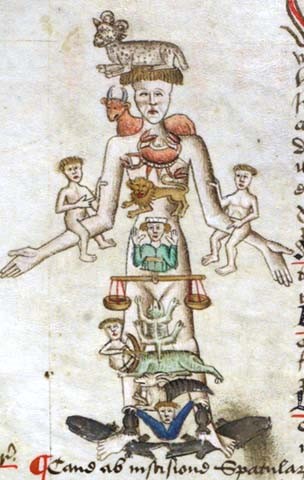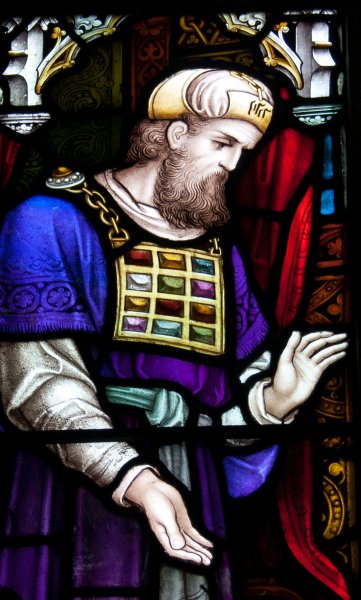| |
Birthstones
The folklore surrounding birthstones has been molded by clever marketing, political intrigue, and cultural perception. One of the most common ideas about the existence of birthstones is that they are based on the Breastplate of Aaron. However, this is a myth that originated outside of Judaism, and the only evidence cited as to how the stones of the breastplate became birthstones is attributed to much later writers in early Christian Europe.
|
Eairly Texts
The earliest writer, Flavius Josephus, had his own reasons for creating the analogy in the 1st century AD. He used the association of the breastplate with western zodiac signs as a way to transform the Hebraic god Jehovah from a national or tribal deity into a universal one with European connections. In doing so he added a great deal of personal interpretation to his historical account in order to support his assertions.
St. Jerome of Stridon was simply attempting to translate the Vulgate. Unfortunately, he used contemporary concepts that later proved to be incorrect such as assuming that there was a direct correlation between the Masoretic Text and Greek Vulgate concerning the gemstones in the breastplate. These texts covered different time periods and show a cultural shift that altered the understanding of which stones comprised the breastplate. In addition, he often fell back to Josephus’ earlier politically charged writings while working on these translations.
Though both Flavius and St. Jerome did attempt to associate these stones with the houses of the zodiac, their writings had nothing to do with our modern idea of birthstones and everything to do with how people cognitive mapped information during their lifetimes. Each of the houses of the zodiac, and by proxy the planets, had associations attached to them that were used to catalog knowledge by grouping it under those signs and planets. For instance, plants that were ruled by Capricorn or Saturn are usually poisonous. This cognitive mapping of ideas was extrapolated to all knowledge of the world as a whole, and would eventually become a key element in medicinal philosophy for centuries to come (See Figure 1). It is important to note that these stones were associated with the houses of the zodiac and not the months of the year. The zodiac signs fall between months on the Gregorian calendar, and so are not related to monthly birthstones as we understand them today.
|

Figure 1: Mirror of Phlebotomy & Practice of Surgery, by John of Arderne, c.1425-1550
Source: Wiki Commons
|
|

Figure 2: Preistly Breastplate. Stained Glass
Ballymote, County Sligo, Ireland
by Andreas F. Borchert
Source: Wiki Commons
|
Breastplate of Aaron
One of the greatest issues in suggesting that the breastplate was the source of modern birthstone folklore is that the stones in the breastplate only very loosely correspond to a few of the birthstones. These few correlations are much more likely due to the limited number of precious stones known to early writers than a direct folkloric correlation. This resulted in a much smaller pool of options to select from when writing about gemstones. By some accounts there are as few as 23 gemstones listed in biblical texts, and many of these occur only a couple of times each. Even completely random selections of 12 stones from a pool of 23 would result in many corresponding stones between attempts. Because of this, special attention must be paid to the order of the stones as well as the stones themselves instead of just their appearance within a group.
The first time we see both a similar set of stones and similar order is in the listing of the foundation stones of New Jerusalem (Revelation 21:12–20). Since the year began in March during the time many of these texts were written, the first foundation stone is associated with that month instead of January. With this in mind the list of foundation stones sync almost perfectly with the earliest birthstone charts. This may be due to an attempt to Christianize earlier beliefs thought of as pagan by associating them with biblical concepts in the New Testament. There is also the possibility that a contemporary translation of the breastplate stones may have been converted into the foundation stones which were then directly associated with the apostles rather than the tribes of Israel.
|
|
The Modern Birthstone Chart
Even as these earliest birthstone charts began to develop, their usage was very different from their purpose today. Modern birthstones are thought as talismanic in that they are believed to provide good luck and other benefits to the wearer if the correct stone associated with the wearers birth month is worn. However, these early stones were amulets that warded off the negative influences of the month with which they were associated. So instead of a single stone to be warn by a person depending on the month of their birth, people possessed sets of stones and changed out their jewelry according to the month. The individual would select the proper stone to wear depending on the current month. Needless to say this practice would have been limited to the wealthy.
During the late 18th century attempts were made to commodify this folk belief for the emerging middle classes who suddenly found themselves in possession of funds. The belief was adapted to single stones because many of the target families were wealthier than their predecessors but not nearly wealthy enough to accessorize like the earlier nobility. This focus on single stones also broadened their client base with less prosperous individuals who wanted to mimic the prosperity of the merchant families by had even less access to such wealth.
As the belief in individualized monthly birthstones grew, merchants and jewelers began to adapt the chart for stones for which they had better access. Around the same time you also begin to see a shift from semiprecious stones to more expensive gems, and the addition of stones like the alexandrite that were never featured in earlier birthstone charts. When the American Jeweler’s Association attempted to “standardize” the many charts by selecting the most expensive stones associated with that month, and switched stones out of contemporary whim. This is the origin of the modern birthstone chart. Within a few years stones on this chart, such as the alexandrite, proved to be so rare and impossibly expensive that they were modified to more traditional selections in order to increase sales for that month.
|
|
|
|
|